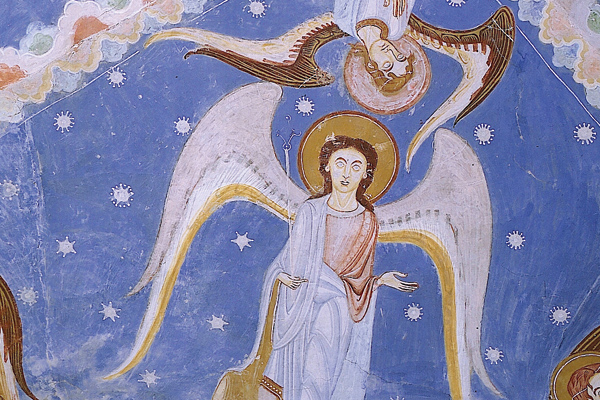How did the cherubim, solemn figures of beaten gold in the Holy of Holies of the Hebrew Temple, become chubby toddlers (such as the pair in Raphael’s Sistine Madonna), popular on greetings cards?
It was surprising in the first place that their graven images should be set up at all, with eyes cast down and wings spread out, shielding the cover of the Ark of the Covenant, where the very glory of the Lord, the shekinah, descended with dangerous power.
For Philo of Alexandria, a Platonist interpreter of Jewish belief, they were the same cherubim that guarded the gates of Paradise (from which mankind had been banished). Valery Rees does not neglect to mention the popular interpretation of God’s powerful presence in the Temple in electro-magnetic terms, as posited in Raiders of the Lost Ark, although, when she refers to the Ark as a ‘thunder-box’, she must be innocently unaware of Apthorpe in Men at Arms.
The origins of cherubim etymologically are apparently not to be found in Hebrew, and gave impetus to those who see angels as a Babylonian invention, all bearded with wings and four clawed legs, as seen in carvings in the British Museum. I can’t help thinking that, though Abraham came from Ur of the Chaldees, Hebrew myth, to which we have a good introduction in the Bible, has quite a different flavour from Babylonian tales. One can hardly think of Andrei Rublev working his artistic miracle expressing God the Holy Trinity in his icon ‘The Hospitality of Abraham’ if the guests had been four-legged winged lions.
In the English Authorised Version of the Bible, cherubim are rather awkwardly called cherubims (a form rather like ‘criterias’ since the -im termination is already plural). But the medieval form had long been cherubin in English, as it was in other European languages, giving us the character Cherubino, the page in The Marriage of Figaro.
By then an even stranger transformation of cherubim had taken place. They had early on been seen as angels given great gifts of knowledge by God — so said the fifth-century Pseudo-Dionysius the Areopagite, probably the most influential supposititious author in European history. So they were often depicted as heads with wings and no bodies. But the classical world already had daemons of their own invention — sprites represented as chubby, winged infants on Greek and Roman tombs.
With the Renaissance, these ever-young putti were copied from the ancients in sculpture, and then painting. By the first decade of the 16th century they were used on neo-classical Christian altars, as in Bendedetto de Rovezzano’s relief made in Florence (now in Washington), where two naked, winged putti hold a plaque reading: ‘Rex regnum et dominus dominantium’ (Revelation, xix 16). These dimpled infants would hardly have prevented Adam and Eve re-entering Eden.
Rees was impelled to embark on her agreeable ramble through the trailing clouds of glory, on the track of cherubim and the other orders of angelic being, by an energetic exploration of the theme on In Our Time. She brings an expert knowledge of the Renaissance writer Ficino, who imported neo-Platonic and Hermetic notions into already bulging trawling-nets of medieval angelology. She is also particularly good on angels in the Jewish world: the Midrashim and the Babylonian Talmud, and the Zohar, the central text of the Cabbala (which she wisely warns is ‘hard to read without some expert guidance’).
Her breadth is astonishing and her judgment almost always good. She is too trusting of the motives of the magus John Dee in summoning angels, just because he said a prayer beforehand, and far too tolerant of present-day writers of pulp-standard angel manuals. She misunderstands too Donne’s ‘worship’ of angels; in ‘Air and Angels’, by ‘Angels affect us oft, and worshipp’d be’, he surely means ‘reverenced’, not ‘adored’. But I only nitpick because I was carried away on her thoroughly enjoyable angelic switchback ride through history.






Comments